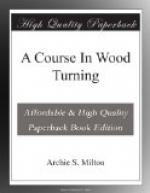In spaces between shoulders, too narrow to permit the use of the skew chisel, very effective work can be accomplished by slightly tipping the parting tool sideways to allow a shearing cut to be taken with the cutting edge.
7. Where several steps are required on the same cylinder, each successive one is worked out as above described.
Note:—All preliminary steps in working stock to size, laying of dimensions, etc., in preparation for the exercise in hand, will be omitted in the following exercises:
Exercise A-I—3-a. Taper Cuts
[Illustration: Fig. 10.]
Calipering for New Diameters. For all diameters on tapers the calipers should be set 1/16” larger than the desired measurement in order to avoid working under size in the finishing cut which removes all caliper marks.
If the taper runs to the extreme end of the cylinder, as in Plate A-I—3-a, a parting tool should be used, instead of a gouge, to take off a very thin shoulder.
If the taper forms an internal angle as in Plate A-I—3-b, a gouge is used as in Step 2—Sizing Cut—Plate A-I—1-a.
In other cases where tapers connect with straight cylindrical shoulders it is best to turn the shoulders to size before working the tapers.
In cutting a long straight taper the skew chisel is used, much in the same manner as in ordinary cylinder work, except that at the start of each cut the heel must be the cutting point. This will avoid any chance of the chisel catching and drawing back and thus gouging the wood beyond the starting point. As soon as the cut is well under way the chisel may be pushed up on the cylinder so that the cutting point is a little above the heel. All cuts should be made from the highest point on the cylinder to the lowest and thus cut across the grain of the wood.
In making the cut, care should be taken to see that the chisel is not tipped to a greater angle than that of the taper wanted. Should that be done a hollow, or dished out, taper is sure to be the result instead of a straight one.
Exercise A-I—4-a. V Cutting
In cutting V’s a small skew is almost always used and the cutting is done with the heel.
Place the chisel square on the tool rest so that the cutting edge is perpendicular to the axis of the cylinder. Draw the chisel back and raise the handle so that the heel is driven into the wood, thus scoring it. This cut should not be too deep or the chisel will burn. This scoring should be at the exact center of the V cut.
Swing the handle a little to the right and at the same time tip the chisel so that the grind, which forms the cutting edge, is at an angle of about 45 deg. with the axis of the cylinder. The handle is then raised at an angle of 45 deg. bringing the heel down to make a good cut. The chisel is then swung to the other side and a similar cut is taken. These cuts are continued, together with the center scoring, until quite close to the pencil marks. Test the angle before the finishing cut is taken.




